Aloo Baingan ki Sabji recipe is a simple and super easy preparation of dry savory and tangy dish made with eggplants, potatoes and spices. This flavorful and healthy Punjabi sabji recipe is a family recipe that I often make and is a variation of the Stuffed Eggplant that I have earlier posted. I am sure you will like this Aloo Baingan Recipe as much as we like. Vegan and gluten-free.
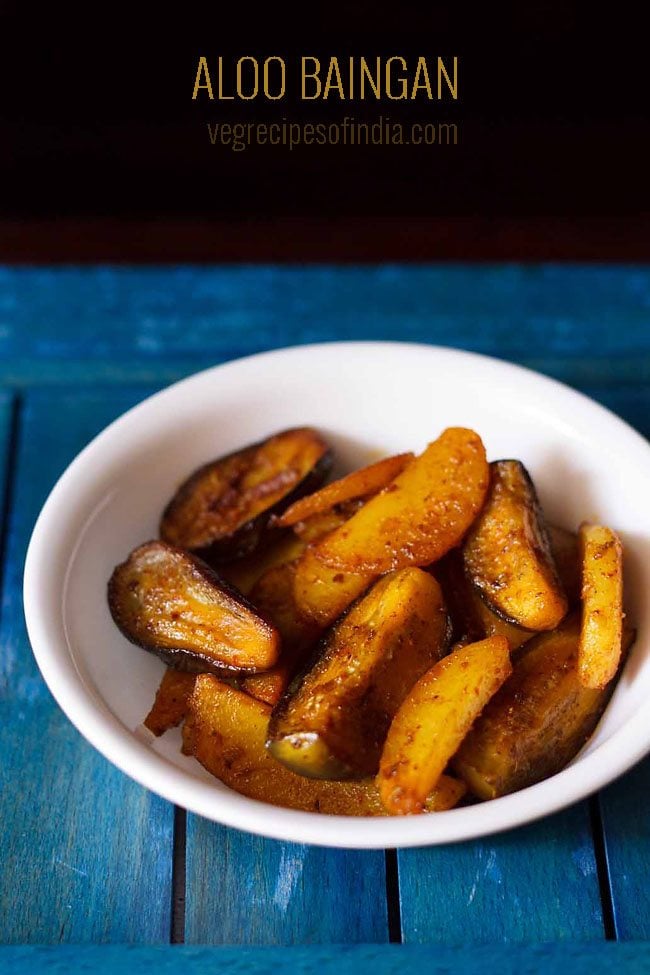
About Aloo Baingan Recipe
This is a dry dish where eggplants and potatoes are cooked in a mix of bold and tangy spices. Eggplants are also called as brinjals and aubergines. In Hindi language they are known as baingan or baigan. Aloo is the Hindi word for potatoes.
There are many ways you can make aloo baingan ki sabzi. We usually add potatoes in this dish to make it more filling and tasty. Of course if you are not fond of potatoes then either reduce the spices or increase the amount of eggplants.
Most varieties of small to medium sized eggplants work well in this dish. Avoid using the large variety of eggplant that we use to make Baingan Bharta as it can become mushy after cooking. The smaller varieties of eggplant are the best to be used in this recipe.
In this baigan sabji recipe, we simply slice or chop the aubergines instead of keeping them whole. Then mix them with the ground spices, seasonings and cook further on low heat.
I have used mustard oil in this recipe but even with a simple vegetable oil like sunflower oil the aloo baingan taste fabulous.
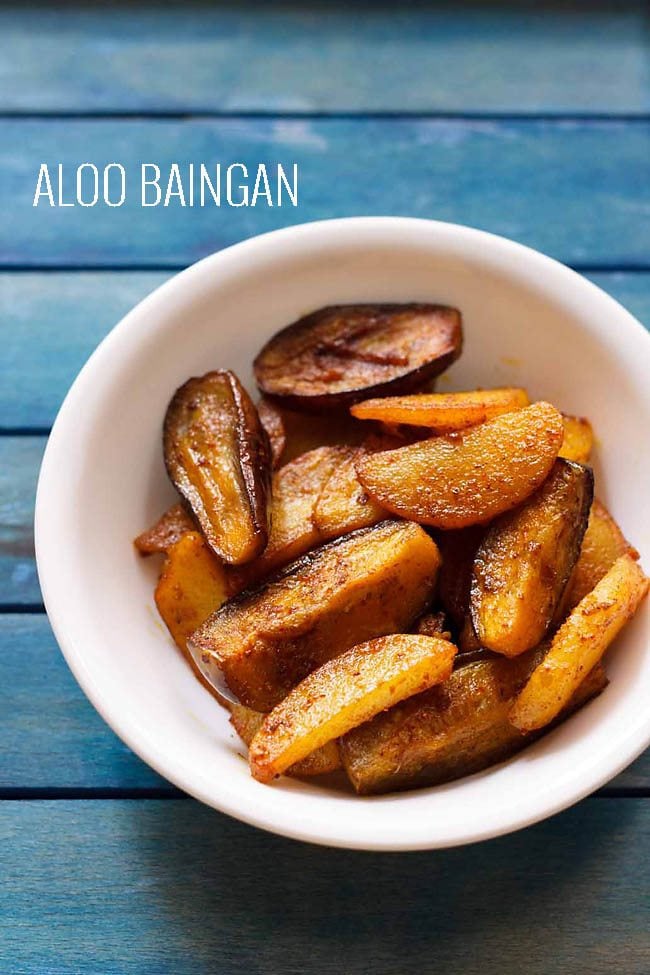
I have learned to make this recipe of aloo baingan sabji from my mother-in-law. Being a fantastic cook, my mother-in-law dishes out awesome Punjabi recipes.
Her trademark is that her recipes are easy to make and yet super yum. They are so easy that even a novice in cooking can make her recipes.
This aloo baingan is one such easy recipe. You can check more simple vegetable sabzi (veggie dishes) like:
You can enjoy this delicious aloo baingan with paratha, phulka and even with whole wheat bread. It makes for a perfect healthy side dish with dal rice or khichdi. You can also make it for tiffin box.
How to make Aloo Baingan ki Sabji
Before you begin to make this easy baigan ki sabji, you need to prep the vegetables. Use any variety of small to medium-sized eggplants but make sure they are fresh and tender. But the smaller variety or baby brinjals give a really good taste.
Preparation
For the potatoes you can regular potatoes or new potatoes or baby potatoes.
1. Wash the small brinjals and potatoes in fresh water a couple of times. Then slice each of the small brinjal into 4 pieces vertically. If the brinjal is of medium-size then first cut into half horizontally and then cut each half into 3 to 4 slices.
Keep the chopped brinjal in salted water for 15 to 20 minutes to remove their bitterness. You can add about ½ teaspoon of salt in a medium size bowl filled with water enough to cover the brinjals.
Note: It is better to soak the brinjals in salted water after cutting them. As this soaking gets rid of any bitterness in them.
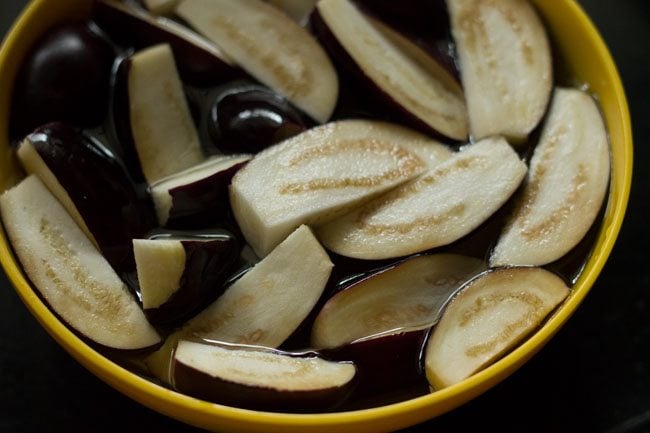
2. Meanwhile peel 5 to 6 medium-sized potatoes. Then cut them into thin to medium-thin slices or wedges as shown in the below photo.
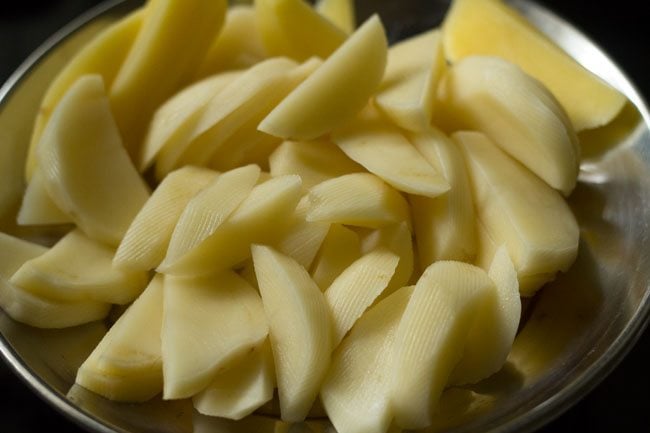
3. In a pan, heat 3 tablespoons of mustard oil or vegetable oil or any neutral flavored oil. Mustard oil gives a nice pungent aroma to this baigan sabji. I usually make this sabji with mustard oil.
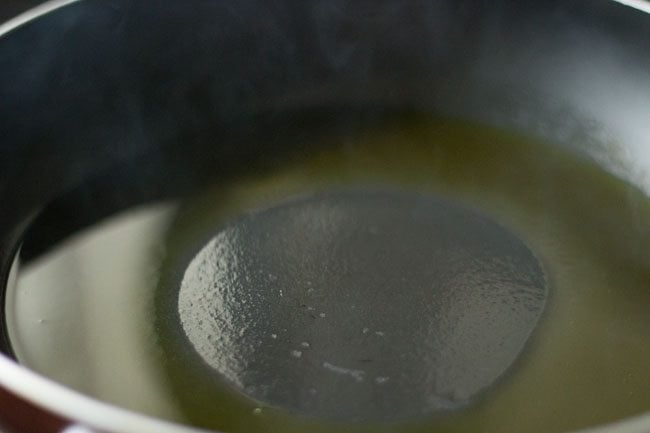
4. Add the potatoes to the oil. Keep the heat to medium-low to medium. Make sure that the pan is well seasoned so that the potatoes don’t stick on to it.
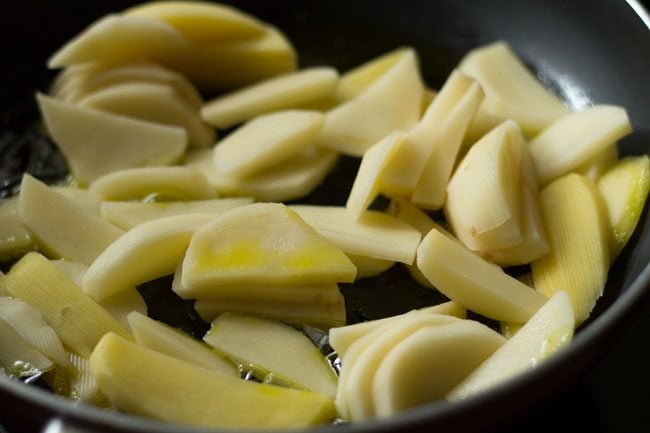
5. Next add the sliced brinjals.
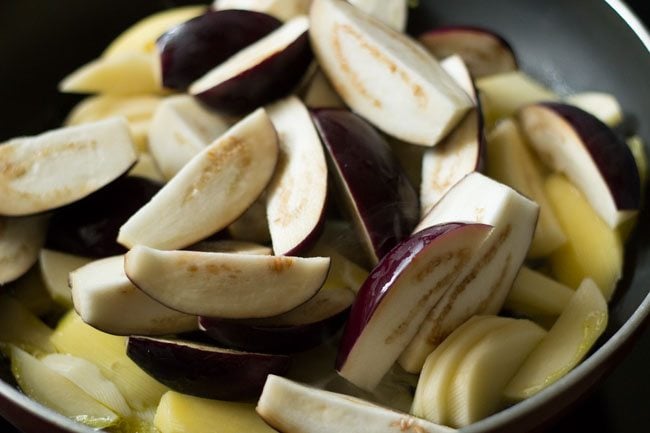
6. Stir and mix well.
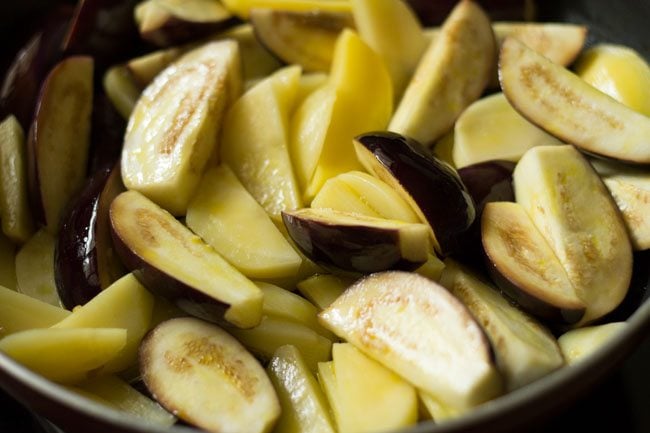
7. Saute in the oil for 4 to 5 minutes on a medium heat.
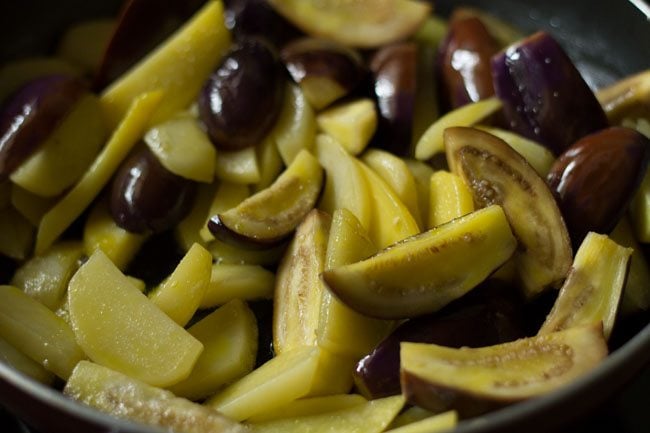
8. Add 2 teaspoons red chili powder, 1 teaspoon turmeric powder and salt as required. You can add regular salt or pink salt.
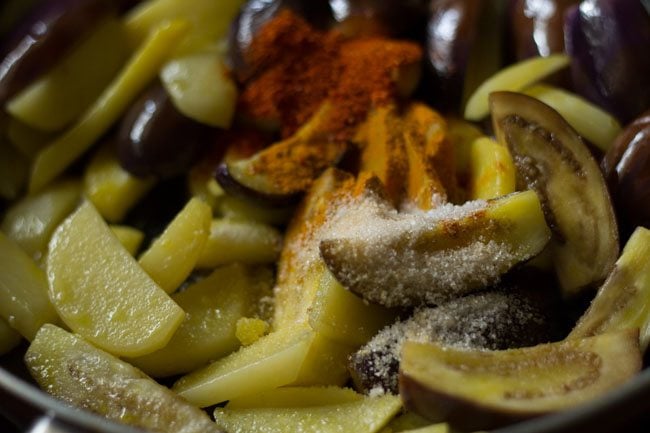
9. Mix the spice powders and salt evenly with the veggies.
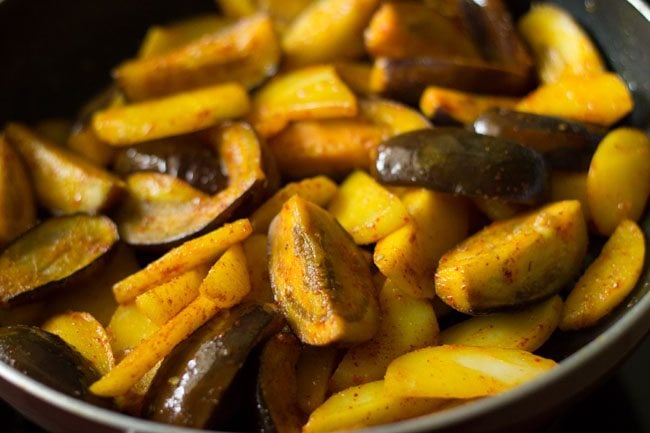
Make Aloo Baingan Sabji
10. Now cover the pan with a lid and let the veggies cook on a low heat for 15 to 20 minutes.
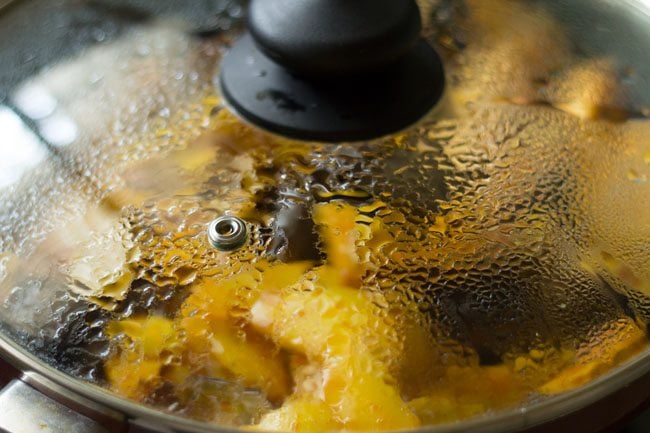
11. In between keep checking the aloo baingan sabzi after a few minutes, so that the veggies do not stick to the bottom of the pan. Do stir occasionally.
If the aloo baigan gets stuck to the pan then add a splash of water. Mix well. Cover with lid and continue to cook on low heat.
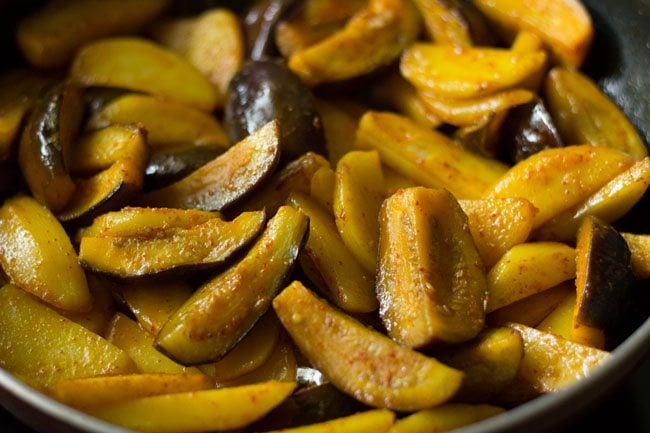
12. Here in below photo, the aloo baingan are cooked till fork tender and softened.
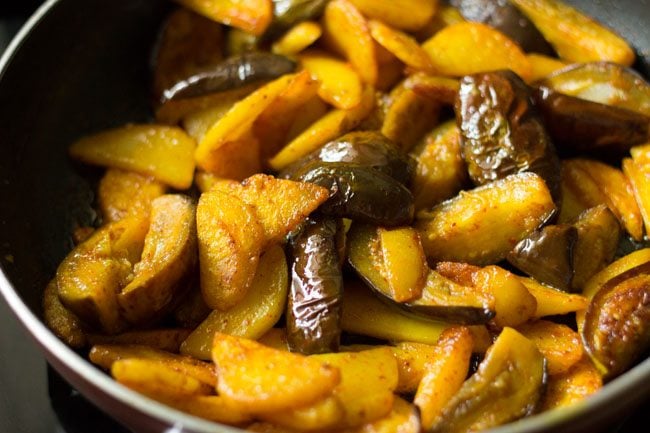
13. Once the veggies are cooked, then sprinkle 2 teaspoon garam masala powder and 2 teaspoon amchur powder (dried mango powder). The dry mango powder imparts a lovely tangy tasty to the sabzi.
If you don’t have dry mango powder then swap with 1 teaspoon of lemon juice.
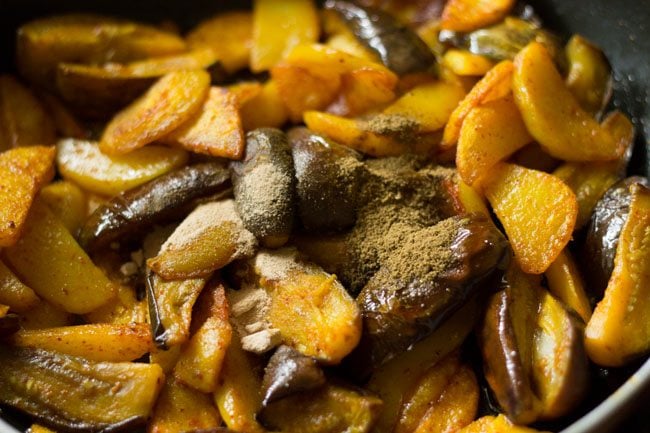
14. Mix well again.
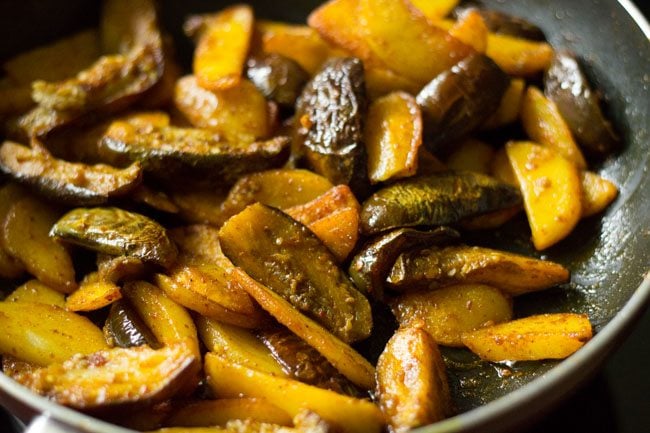
15. Cook for a minute without the lid.
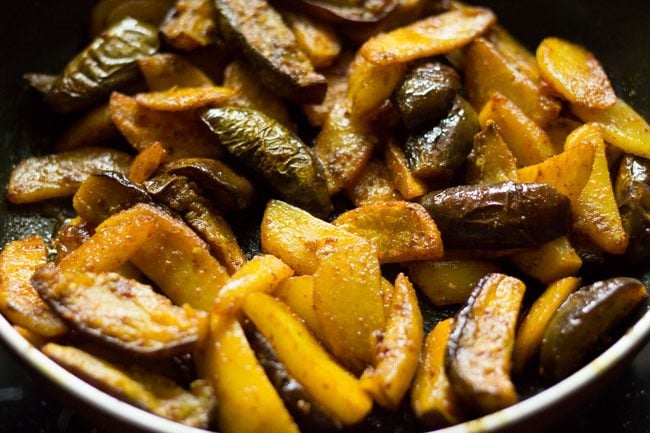
16. Close the heat and serve the aloo baingan sabji hot or warm with phulka or paratha accompanied with a side of dal, curd or raita of your choice.
It makes for a good dish to be packed in lunch box with a side of roti or whole wheat bread.
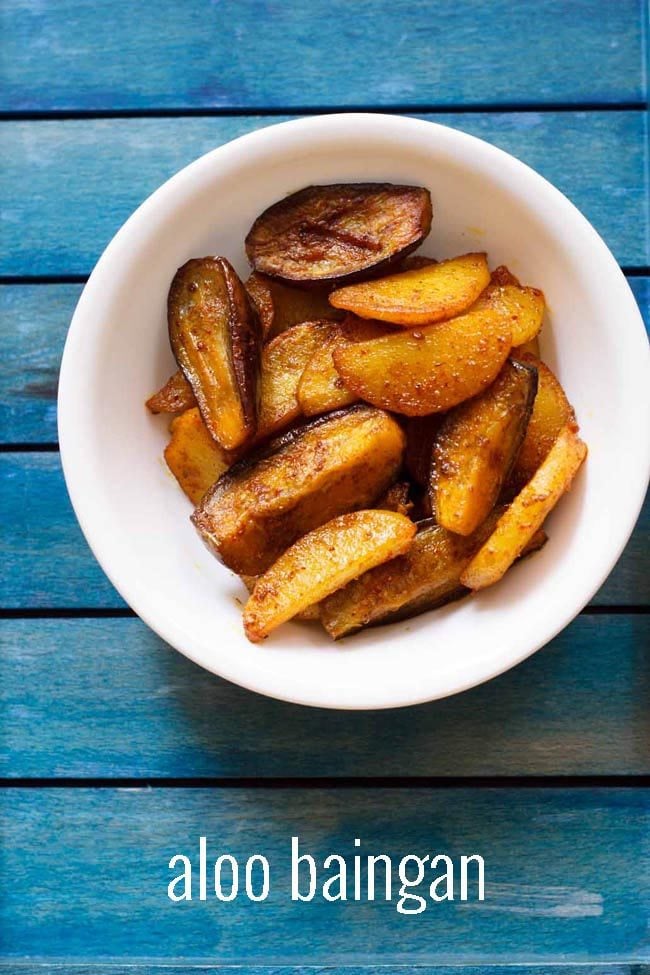
More Eggplant Recipes To Try!
Brinjal Recipes
Brinjal Recipes
Brinjal Recipes
Karnataka Recipes
If you’ve tried this recipe, please rate it in the recipe card or leave a comment below – I’d love to hear your feedback. For more vegetarian inspiration, sign up for my email updates or follow me on Instagram, Youtube, Facebook, Pinterest or X.
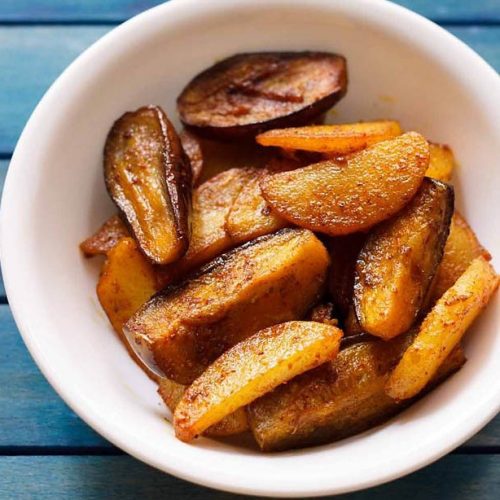
Aloo Baingan Recipe (Punjabi Style)
Ingredients
- 1 kg small baingan (eggplants or brinjals)
- 5 to 6 potatoes – medium sized
- 2 teaspoon Red Chilli Powder or paprika or cayenne pepper
- 1 teaspoon turmeric powder
- 2 teaspoon dried mango powder (amchur powder)
- 2 teaspoon Garam Masala
- 3 tablespoon mustard oil or vegetable oil
- salt or pink salt
Instructions
Preparation
- Wash the small brinjals and potatoes in fresh water a couple of times.
- Slice the brinjals into 4 pieces vertically. If the brinjal is of medium-size then first cut into half horizontally and then cut each half into 3 to 4 slices.
- Keep the brinjals in salted water for 15 to 20 minutes to remove their bitterness.
- Also slice the potatoes into thin to medium-thin wedges or slices.
Making aloo baingan ki sabji
- In a pan heat the mustard oil. Add the potatoes and brinjals to the oil.
- Saute in the oil for 4 to 5 minutes on a medium heat.
- Add red chilli powder, turmeric powder and salt as required.
- Mix the spice powders and salt evenly with both the veggies.
- Now cover the pan with a lid and let the veggies cook on low heat for 15 to 20 minutes.
- Keep checking the aloo baingan after a few minutes so that the veggies do not stick to the bottom of the pan. Do stir occasionally.
- When the aloo and baingan are cooked until fork tender and softened, then sprinkle garam masala powder and dry mango powder.
- Mix these thoroughly and cook for a minute without lid
- Close the heat and serve the aloo baingan sabji hot with phulka or paratha or whole wheat bread. It makes for an excellent side dish with dal rice or khichdi.
Notes
- Use fresh and tender brinjals. Preferably try to make this dish with a smaller variety of brinjals or eggplants. You can also use medium-sized brinjals. But avoid making with the larger variety of brinjals that we used to make baingan bharta.
- The regular potatoes, baby potatoes and new potatoes works well in this recipe.
- You can skip adding potatoes you want to only make baigan ki sabji. But then either increase the quantity of brinjals or reduce the spices according to your taste preferences.
- Make sure not to slice the potatoes thickly as they will be undercook by the time the brinjals are cooked. So slice them into thin or medium-thin wedges or slices.
- Mustard oil gives a good smoky and pungent flavor. But you can use any neutral flavored oil also.
- If you want you can garnish the aloo baigan with some chopped coriander leaves.
- The recipe can be scaled to make a smaller batch.
Nutrition Info (Approximate Values)
Aloo Baingan recipe from the archives was first published on April 2011.
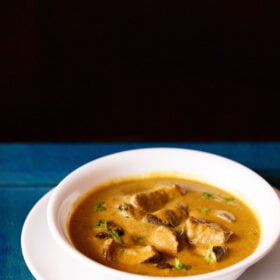
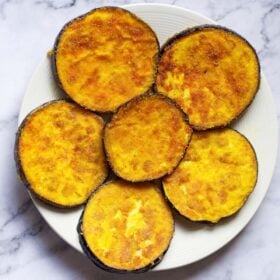
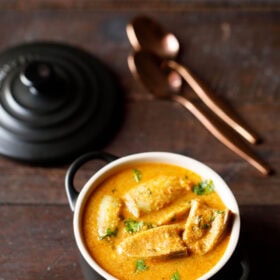
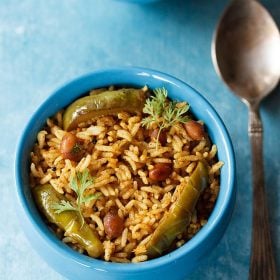
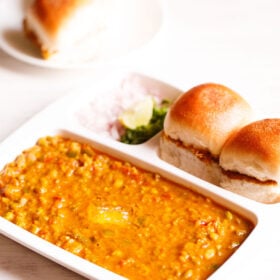
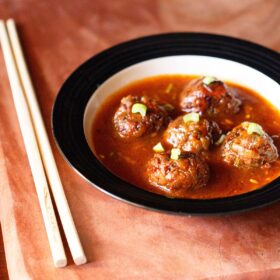
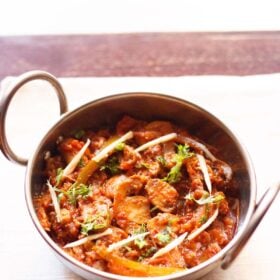
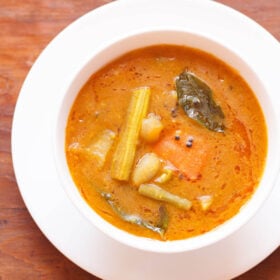








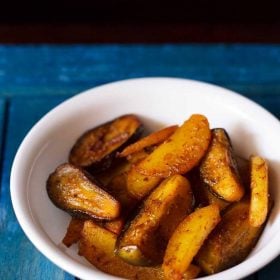
Comments are closed.